By Jeffrey A. Rendall, Photos By Jeffrey A. Rendall
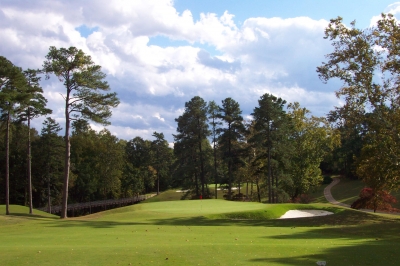 |
| The short par four 13th hole (347 yards) plays downhill, just begging for long hitters to have a go at it. But if you miss, you'll pay. |
RICHMOND, VA – “The course was renovated in 1992, but we restored it in 2003-04,” claimed Golf Architect Lester George, speaking of the Country Club of Virginia’s James River Course.
There are those who might think the two terms are birds of a feather, but Lester gets a little defensive when you even imply that’s the case. George insists that this classic golf course had changed over time, not for the better, and his intent was to go in there, move some things around, re-grass the course, and most importantly, bring back the original strategy of the design. “That’s not a renovation. If you don’t want to bring it back to the way it was, then you can call it a renovation. If you’re true to the original, that’s a restoration,” George reiterates.
And even though some may disagree on what to call it, the work that was done on one of Virginia’s oldest and most traditional golf designs has ‘restored’ the grandeur of the old dame, pleasing members and guests alike. There are certainly ‘bigger’ courses and layouts that will ‘wow’ you with scale – but when it comes to garnering an old-style sense of heritage and history, there’s none better than the James River Course.
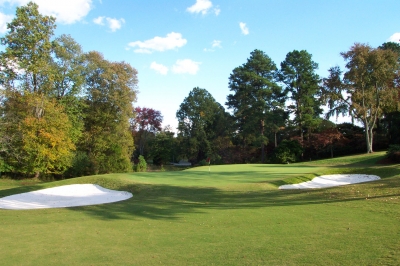 |
| Greenside at the par five 16th hole. There's only a little room for those trying to get there in two. |
The course was built in 1928, the product of the fertile mind of William Flynn, one of the Mid-Atlantic’s most prolific and productive designers of his time (of the firm Toomey & Flynn, out of Philadelphia). Flynn’s Cascades Course at The Homestead continues to rank number one in the state in most publications’ lists, and if more folks had a chance to see his work at the CCVA (it’s a private club), the James River Course might enjoy higher rankings as well.
Flynn’s construction supervisor at CCVA was none other than Scottish born Fred Findlay, another famous name in Virginia classic golf lore. Findlay built the course, served as its superintendent for the first few years, then moved on to a very distinguished solo architectural career, designing dozens of golf courses in the Old Dominion (including Farmington Country Club in Charlottesville).
Richard Cromwell, the CCVA’s Head Golf Professional, helps fill in some more of the course’s history: “When Flynn originally designed the holes on this site, he actually scripted out thirty-six – one layout was called the ‘Valley’ Course, the other the ‘Hill’ Course. We’re not entirely sure why all the holes weren’t built, but what they ended up doing was taking nine from each – the James River’s front nine, laying kind of low, was from the Valley design and the back nine, more undulating, was from the Hill portion.”
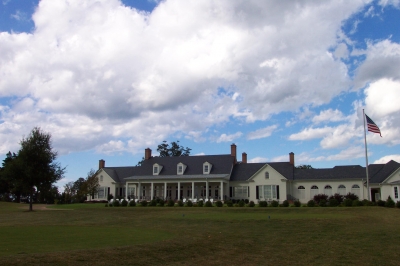 |
| The Country Club of Virginia's clubhouse design is a perfect compliment to the club's atmosphere -- gentile and friendly. |
Part of the reason for the reduction in scale at the time was the club didn’t actually own all the land that the courses would’ve occupied – and even though this area was truly out in the ‘country’ in those days, you can’t build on what you don’t own. Cromwell said the property itself was a former plantation and there are still a few signs from its historic past, namely an old slave quarters on the left of hole number ten, and the plantation house was the club’s first clubhouse.
The club acquired quite a historic significance in the golf sense as well, as the James River Course hosted the 1935 Southern Amateur (also in 1967), then the 1955 and 1975 United States Amateur Championships, amongst others.
Continuing in the historic name-dropping -- in 1992, Rees Jones was brought in to do a renovation of the course, and he changed the bunkering and the greens in an attempt to bring it up to more modern standards of playability.
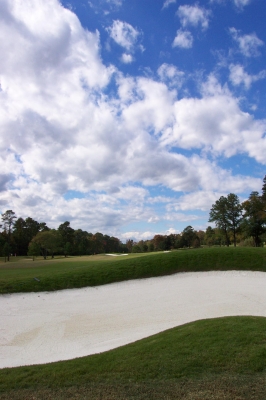 |
| George moved the bunkers back into play, and this one, on the par five 6th hole, certainly fits that description. I know from experience. |
In the early 2000’s, the club’s membership decided it was time to try again, this time a restoration. George explains why, and how: “The James River Course remained pretty much the same for the first decade or so of its existence. Then, about 1938, a gentleman named George O’Neil came in and made some renovations, though it’s not clear to anybody exactly what he did.”
He continues, “So we set out to discover what the course was like before Flynn’s work had been altered. Of course, nobody really remembered what it was like prior to 1950 – mostly because not that many people had actually played it back then, and also because they’d made significant changes in the early fifties, getting ready to host the US Amateur in 1955.”
Something more was needed to tell the tale. There were some vague sketches and drawings from Flynn’s time, but if George and the CCVA folks had had a hard time figuring out what holes went with which from the original ‘Hill’ and ‘Valley’ layouts, then there wasn’t enough in the written records to bring out Flynn’s original intent from his etchings alone.
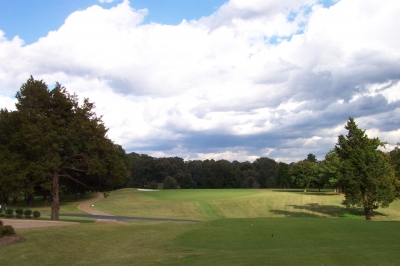 |
| The challenging par four 10th hole doglegs left. There's plenty of room to miss right off the tee, but then you're digging a hole for your approach shot. |
George’s associate, Andy Frank, helped supply the answer. “After searching, we were able to locate a 1937 aerial photograph of the James River Course that no one knew existed – Andy Frank found it, and he deserves a lot of credit. So we had a perfect reference point to design the course’s restoration around.”
It wasn’t a strict restoration, since the changes to the land itself would make that impossible – namely a couple lakes added on the front nine along holes number one and six (there were bunkers there originally). George said the most important thing was to try and bring back the strategy that Flynn had installed, something that had been wiped away through years of changes and improvements in modern equipment.
“We built a new sixth hole, a new eighteenth hole and a new fourth hole. The rest we pretty much restored in place,” George said. “That mainly consisted of re-doing the greens, building the fairway bunkers back to the way they were, which was ‘turned in.’ They were more perpendicular to the line of play under Flynn’s design, instead of flaring out after they’d been redone.”
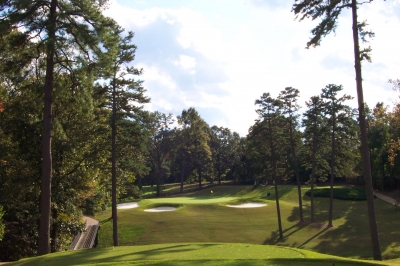 |
| One of only two holes you can't run it up to the green, the 218-yard par three 14th hole is a lot more difficult than its #14 handicap designation would indicate. |
Some of the bunkers had been turned so far out that they really were no longer a hazard – you could just play around them. Then tee positions were moved to bring the bunkers back into play for modern golf’s technological advancements.
In other words, now you have to play William Flynn’s golf course, instead of blasting over or around everything.
Cromwell said the first priority, when the project started, was only to redo the greens. “We realized there were a lot of new varieties of bentgrass out there, and we’d just gone though a particularly bad drought period where our greens didn’t do very well. We needed something that would stand up to the heat and play at this club. There was also some drainage work that had to be done, that type of thing.”
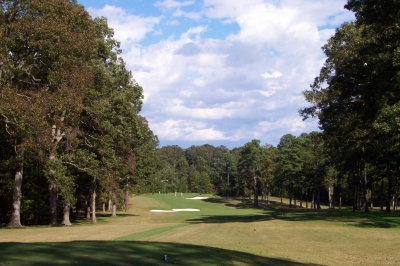 |
| The fairway bunker suggests the shot to play off the tee of the par four 11th hole. |
As soon as they started the work, however, the focus changed. Instead of just making those few initial changes, the club members decided to redo the whole thing while the course was closed. They ended up putting beautiful and playable TifSport Bermuda grass in the fairways and A4 Bentgrass on the greens. A4 demands a short mowing, so the green slopes had to be redone in order to accommodate it (although only two greens were completely changed, the fourth and eighteenth).
“We restored back the contours in the greens as close as we could decipher from the photograph,” George explained. “We also put the mowing patterns back in. We basically took out what we thought was un-Flynn-like, and added bunkers where they were or where we know Flynn would have put them.”
So there admittedly were some changes, even from Flynn’s original layout. How then, can you call it a restoration as opposed to a renovation?
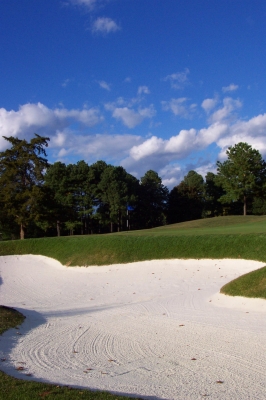 |
| The greenside bunkers on the James River Course aren't overly deep, but you'll still test your sand skills if you find too many of them. |
George retorts: “It’s not like you use the photograph as a proof-positive document – but you can use it to say, ‘Here’s what you had, and here’s what you don’t have anymore because this is missing.’ If they don’t want to do it that way, fine, but just don’t call it a restoration.”
Okay, how about the brand new fourth hole?
“Some people say because we changed the fourth hole that it’s not a restoration – but that’s not in fact, true. We took the green, which was 8,200 square feet in size and restored it back to the original size, which was more like 5,100 square feet. There was never any green on the golf course that was even close to approaching that size,” George said.
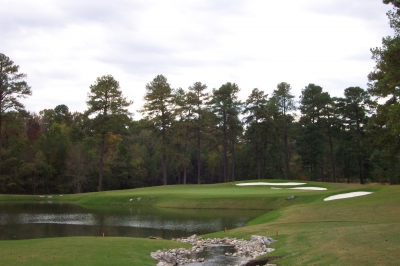 |
| The par three 4th hole is brand new -- but George says the green was restored back to its original size, and the pond and creek are there to help out with drainage. |
“We did install the stream and the pond, but that was to help fix a bad drainage situation that they’d experienced for years. It’s very aesthetic and we added a re-circulation pump that flows water through the creek to keep the pond from becoming stagnant – you know, eliminate the mosquitoes,” George added.
Case closed. We’ll rule in George’s favor, it’s a restoration.
Cromwell talks about the end product. “It’s a traditional design, not tricked up, without a lot of forced carries – but that was a goal. We wanted to provide as many options as we could for the members, so that we could make it more playable for a thirty-handicap while not impacting the scratch player. Because of that, we got pretty creative with the tees.”
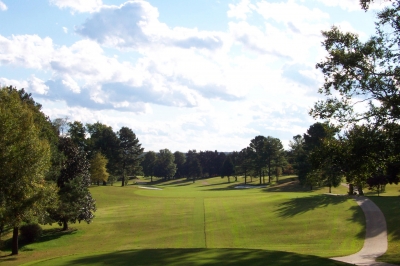 |
| It looks like you can blast the ball just about anywhere off the tee of the par five 16th hole, but you'll still want to hit the fairway, if you're wise. |
And the strategic qualities are back, too. The course plays fairly narrow, with much of it lined by large, mature trees. There’re still plentiful playing areas, it’s just that there’s a renewed urgency to hit the fairways in order to leave a good position for playing into the greens. The ‘new’ rough is being maintained to 2 ½ inches, but if you’re in that stuff, you’ll have a hard time advancing it to your intended destination. So much for the new and improved conditions!
The James River Course is also friendly to the high handicappers, with all but two greens open to a run-up shot. Missing short won’t kill you here, and as with most classic designs, you can get creative with your short game should you miss the putting surface with your approach. It’s not a course where the membership will complain of too much difficulty, yet it’s not a push-over either. On most holes there’s a ‘safe route,’ which harkens back to more traditional design features, instead of everything having to be done through the air, in a target game. That’s nice.
There may only be four sets of markers out at any one time, but there are actually six golf courses to play, ranging from 5,142 yards to just over 7,000 from the tips. Cromwell said they added twelve new tee boxes, total – four in front, four in back and four kind of in the middle. There’s something for everybody now at the James River Course.
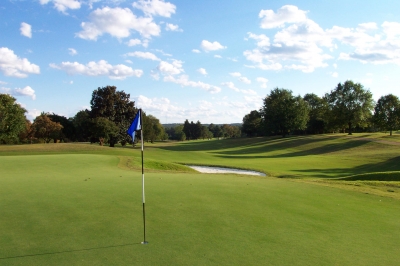 |
| Looking back from the green of the par five 18th hole -- a look back to the way it was in the old days, and it's a great view. |
It’s golf the way it was, and the way it should be. Thank God for early aerial photography – which allows us to toss the renovation ideas right out the window. Williams Flynn’s back, and if the folks at the Country Club of Virginia have anything to say about it, he’ll never again be forced to leave. Ever.
Note: Our thanks to Richard Cromwell and Lester George for inviting me to see and feature this beautiful course, as well as to Assistant Professionals Tim Dale and Mark Balch for helping me to learn the course – in my case, every inch of it.
Details:
| Related Links | Comments on this article? | |
|
Maryland National Golf Club Hollow Creek Golf Club Rocky Gap Resort PB Dye Golf Club in Ijamsville Whiskey Creek Golf Club |
E-mail Jeff Rendall, Editor: jrendall@golftheunitedstates.com |











